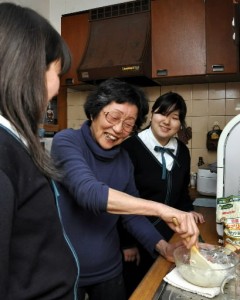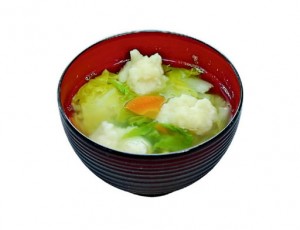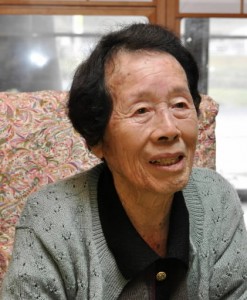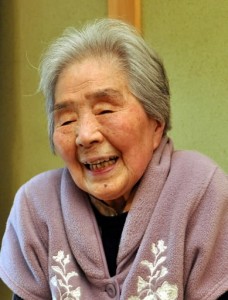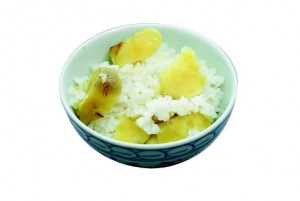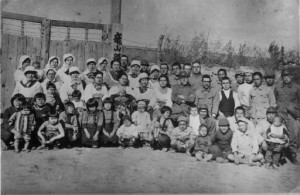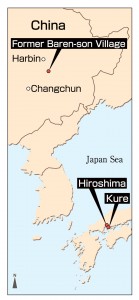Peace Seeds: Teens in Hiroshima Sow Seeds of Peace (Part 30)
Mar. 24, 2016
Part 30: Food shortages during wartime
As Japan continued to wage war in the first half of the 20th century, food shortages in the country grew worse. In 1938, the Japanese government enacted the National Mobilization Law, and from that point put priority on the nation’s military affairs. The government stressed such slogans as “Luxury is the enemy” and “I won’t demand anything until we win” and forced the Japanese people to live a frugal life, saying that they should share in the feelings of being on the battlefield even though they were at the home front.
The junior writers of the Chugoku Shimbun learned how to make meals that were eaten during this time of war from three women, around 90 years old, who cooked these meals back then. Flour dumplings boiled in soup, boiled corn, and sweet potato rice were the meals made to fill people’s stomachs while using as little rice as possible.
Unlike today, people then were not able to freely eat what they like. They simply ate to survive more than to enjoy the food they consumed. Reflecting on the meals eaten at that time, we learned how hard their lives were during and after the war.
Forced to live frugal lives: Food shortages and lack of rationed food
Food supplies in Japan dwindled at that time for these reasons: the amount of food needed for the military increased sharply; farm families faced a labor shortage because male farmers were mobilized for the war effort, thus crop yields fell dramatically; and imports from abroad were halted. Japan was forced to feed itself and food shortages became dire, particularly in urban areas.
Under these circumstances, food began to be rationed. The Japanese government restricted the distribution of rice, flour, sugar, and other food items. Each household was able to purchase only the amount specified on a ticket that they received. These amounts were limited, though, and food was not distributed frequently. This is what triggered the rise of a black market, where goods were bought and sold outside the rationing system.
As a substitute for staple foods, the Japanese people began to grow sweet potatoes, which were easy to produce on open land. Despite the end of the war in 1945, this shortage of food persisted until around 1950. (Kantaro Matsuo, 17)
Yachiyo Kato in Nishi Ward, Hiroshima: Sharing food among family members
During the war, Yachiyo Kato, 87, a resident of Nishi Ward who experienced the atomic bombing at the age of 16, would eat flour dumplings boiled in soup for dinner. This is a meal made of flour instead of precious rice.
To cook this dish, put thinly sliced Japanese radish, carrot, and Chinese cabbage in broth made from dried sardine. When the broth comes to a boil, add dumplings made of thick flour and water and boil until the dumplings float to the surface of the broth. Ms. Kato recalled the smell of the broth and its mild taste. Back then, people would add homegrown vegetables to the soup. Because of the blackout in effect, to guard against air raids, electric lights had to be switched off and so they sometimes ate in the dark, but Ms. Kato remembers being happy as she ate dinner with her family.
At the time, Ms. Kato was a student in the advanced course at Hiroshima First Municipal Girls’ School (now Funairi High School). On August 6, 1945, she experienced the atomic bombing near Koi Station (now Nishihiroshima Station in Nishi Ward), about 2.5 kilometers from the hypocenter. She was suddenly blown off her feet by the A-bomb blast, and she blacked out. She had a day off from the factory where she was mobilized to work for the war effort, so she and a friend were headed to Miyajima. She managed to escape serious injury and walked to her home in Mukainada-nakamachi (now part of Minami Ward), arriving that night. Her father was surprised to see that she was still alive.
Ms. Kato said that everyone had to cooperate to survive. It was a time when family members all shared small amounts of food. We felt comfortable with these three women, as we made the flour dumplings boiled in broth, and sensed that this taste reminded Ms. Kato of her youth. (Kana Fukushima, 17 and Marika Tsuboki, 16)
Toshiko Ishibashi in Kitahiroshima: Working the land as pioneers
Toshiko Ishibashi, 92, a resident of the town of Kitahiroshima, spent about three years, up until the end of the war, in Manchuria (today’s northeastern China). She was in the village of Baren, a “sister village” of Shinjo (now part of the town of Kitahiroshima), working the land there with a group of Japanese pioneers. She said she lived on corn that grew plentiful.
One unique feature of corn is that it can grow even on barren land. After it was harvested, it was boiled or baked on the cooking stove of ondol, a floor heater. To prepare for winter, when the temperature plummeted to 40 degrees below zero, corn kernels were dried and stored. Ms. Ishibashi also grew watermelons and tomatoes, and said they had no difficulty living from day to day.
Repatriating from China after the war was a harsh experience. Repatriates rode on freight cars without roofs and walls, and Ms. Ishibashi desperately held her newborn daughter in her arms for a day and a half so that she would not be thrown off the freight car. When the train stopped along the way, her husband took carrots from someone’s field, and Ms. Ishibashi and her daughter were able to endure thanks to this food.
After that, they boarded a ship and railway cars and returned to Hiroshima. Along the way, she came across a dead baby, all alone. It was heartbreaking for Ms. Ishibashi, and she laid a handkerchief over the baby’s face. “We really had terrible times. I feel grateful for the present because we can buy and eat what we like,” she said with tears in her eyes. (Kantaro Matsuo, 17 and Hiromi Ueoka, 15)
Hiroko Yamamoto in Kure: “Just feeling full was enough”
During that time, Hiroko Yamamoto, 91, a resident of the city of Kure, worked for the Kure Navy accounting department. She remembers eating sweet potato rice after the war, when food shortages grew even worse. She said, “We couldn’t enjoy the food, and just feeling full was enough for us.”
During the war, her family had plenty of rice because her parents had farmland in the town of Yasuura (now part of the city of Kure). But after the war, by order of the U.S. military, her parents were forced to give up this land and it was rented out by the landowner to tenant farmers. They now were short of rice and cooked it with sweet potatoes which were cut into small pieces.
Since war broke out, when “Luxury was the enemy,” Ms. Yamamoto grew sweet potatoes on the roadside in front of her home. She seasoned the stems of the sweet potatoes with soy sauce diluted with seawater, then boiled and ate them, too. She developed the deeply ingrained habit of eating as much as possible, in a short period of time, in case U.S. air raids would strike the city. She has grown old now, but she never leaves food from her meals unfinished because she feels this would be wasteful. (Hiroyuki Hanaoka, 14)
Keywords
Japanese immigrants to the village of Baren and Manchuria (northeastern China)
Under Japanese policy of the time, the village of Shinjo (now part of the town of Kitahiroshima) sought to establish a second village, a “sister village,” in Manchuria. With the aim of increasing food production and improving conditions in Manchuria, 220 households, or half the number of households in Shinjo, were assigned to emigrate and settle on farms in Manchuria, one farm per family. According to the Oasa Town History, the village of Baren was established in Manchuria in 1940. After that, Japanese nationals came to the village in five waves, with a total of 453 people, in 127 households, living there in April 1945. The History of Hiroshima Prefecture records that 11,000 people emigrated to Manchuria from the prefecture. In the chaotic conditions of repatriating from China after the war, many people became separated from their parents or other family members and were left behind by themselves in China.
What is Peace Seeds?
Peace Seeds are the seeds of smiles which can be spread around the world by thinking about peace and the preciousness of life from various viewpoints. To fill this world with flowering smiles, 44 junior writers, from the sixth grade of elementary school to the fifth year of high school, choose themes, gather information, and write articles.
(Originally published on March 24, 2016)
As Japan continued to wage war in the first half of the 20th century, food shortages in the country grew worse. In 1938, the Japanese government enacted the National Mobilization Law, and from that point put priority on the nation’s military affairs. The government stressed such slogans as “Luxury is the enemy” and “I won’t demand anything until we win” and forced the Japanese people to live a frugal life, saying that they should share in the feelings of being on the battlefield even though they were at the home front.
The junior writers of the Chugoku Shimbun learned how to make meals that were eaten during this time of war from three women, around 90 years old, who cooked these meals back then. Flour dumplings boiled in soup, boiled corn, and sweet potato rice were the meals made to fill people’s stomachs while using as little rice as possible.
Unlike today, people then were not able to freely eat what they like. They simply ate to survive more than to enjoy the food they consumed. Reflecting on the meals eaten at that time, we learned how hard their lives were during and after the war.
Forced to live frugal lives: Food shortages and lack of rationed food
Food supplies in Japan dwindled at that time for these reasons: the amount of food needed for the military increased sharply; farm families faced a labor shortage because male farmers were mobilized for the war effort, thus crop yields fell dramatically; and imports from abroad were halted. Japan was forced to feed itself and food shortages became dire, particularly in urban areas.
Under these circumstances, food began to be rationed. The Japanese government restricted the distribution of rice, flour, sugar, and other food items. Each household was able to purchase only the amount specified on a ticket that they received. These amounts were limited, though, and food was not distributed frequently. This is what triggered the rise of a black market, where goods were bought and sold outside the rationing system.
As a substitute for staple foods, the Japanese people began to grow sweet potatoes, which were easy to produce on open land. Despite the end of the war in 1945, this shortage of food persisted until around 1950. (Kantaro Matsuo, 17)
Yachiyo Kato in Nishi Ward, Hiroshima: Sharing food among family members
During the war, Yachiyo Kato, 87, a resident of Nishi Ward who experienced the atomic bombing at the age of 16, would eat flour dumplings boiled in soup for dinner. This is a meal made of flour instead of precious rice.
To cook this dish, put thinly sliced Japanese radish, carrot, and Chinese cabbage in broth made from dried sardine. When the broth comes to a boil, add dumplings made of thick flour and water and boil until the dumplings float to the surface of the broth. Ms. Kato recalled the smell of the broth and its mild taste. Back then, people would add homegrown vegetables to the soup. Because of the blackout in effect, to guard against air raids, electric lights had to be switched off and so they sometimes ate in the dark, but Ms. Kato remembers being happy as she ate dinner with her family.
At the time, Ms. Kato was a student in the advanced course at Hiroshima First Municipal Girls’ School (now Funairi High School). On August 6, 1945, she experienced the atomic bombing near Koi Station (now Nishihiroshima Station in Nishi Ward), about 2.5 kilometers from the hypocenter. She was suddenly blown off her feet by the A-bomb blast, and she blacked out. She had a day off from the factory where she was mobilized to work for the war effort, so she and a friend were headed to Miyajima. She managed to escape serious injury and walked to her home in Mukainada-nakamachi (now part of Minami Ward), arriving that night. Her father was surprised to see that she was still alive.
Ms. Kato said that everyone had to cooperate to survive. It was a time when family members all shared small amounts of food. We felt comfortable with these three women, as we made the flour dumplings boiled in broth, and sensed that this taste reminded Ms. Kato of her youth. (Kana Fukushima, 17 and Marika Tsuboki, 16)
Toshiko Ishibashi in Kitahiroshima: Working the land as pioneers
Toshiko Ishibashi, 92, a resident of the town of Kitahiroshima, spent about three years, up until the end of the war, in Manchuria (today’s northeastern China). She was in the village of Baren, a “sister village” of Shinjo (now part of the town of Kitahiroshima), working the land there with a group of Japanese pioneers. She said she lived on corn that grew plentiful.
One unique feature of corn is that it can grow even on barren land. After it was harvested, it was boiled or baked on the cooking stove of ondol, a floor heater. To prepare for winter, when the temperature plummeted to 40 degrees below zero, corn kernels were dried and stored. Ms. Ishibashi also grew watermelons and tomatoes, and said they had no difficulty living from day to day.
Repatriating from China after the war was a harsh experience. Repatriates rode on freight cars without roofs and walls, and Ms. Ishibashi desperately held her newborn daughter in her arms for a day and a half so that she would not be thrown off the freight car. When the train stopped along the way, her husband took carrots from someone’s field, and Ms. Ishibashi and her daughter were able to endure thanks to this food.
After that, they boarded a ship and railway cars and returned to Hiroshima. Along the way, she came across a dead baby, all alone. It was heartbreaking for Ms. Ishibashi, and she laid a handkerchief over the baby’s face. “We really had terrible times. I feel grateful for the present because we can buy and eat what we like,” she said with tears in her eyes. (Kantaro Matsuo, 17 and Hiromi Ueoka, 15)
Hiroko Yamamoto in Kure: “Just feeling full was enough”
During that time, Hiroko Yamamoto, 91, a resident of the city of Kure, worked for the Kure Navy accounting department. She remembers eating sweet potato rice after the war, when food shortages grew even worse. She said, “We couldn’t enjoy the food, and just feeling full was enough for us.”
During the war, her family had plenty of rice because her parents had farmland in the town of Yasuura (now part of the city of Kure). But after the war, by order of the U.S. military, her parents were forced to give up this land and it was rented out by the landowner to tenant farmers. They now were short of rice and cooked it with sweet potatoes which were cut into small pieces.
Since war broke out, when “Luxury was the enemy,” Ms. Yamamoto grew sweet potatoes on the roadside in front of her home. She seasoned the stems of the sweet potatoes with soy sauce diluted with seawater, then boiled and ate them, too. She developed the deeply ingrained habit of eating as much as possible, in a short period of time, in case U.S. air raids would strike the city. She has grown old now, but she never leaves food from her meals unfinished because she feels this would be wasteful. (Hiroyuki Hanaoka, 14)
Keywords
Japanese immigrants to the village of Baren and Manchuria (northeastern China)
Under Japanese policy of the time, the village of Shinjo (now part of the town of Kitahiroshima) sought to establish a second village, a “sister village,” in Manchuria. With the aim of increasing food production and improving conditions in Manchuria, 220 households, or half the number of households in Shinjo, were assigned to emigrate and settle on farms in Manchuria, one farm per family. According to the Oasa Town History, the village of Baren was established in Manchuria in 1940. After that, Japanese nationals came to the village in five waves, with a total of 453 people, in 127 households, living there in April 1945. The History of Hiroshima Prefecture records that 11,000 people emigrated to Manchuria from the prefecture. In the chaotic conditions of repatriating from China after the war, many people became separated from their parents or other family members and were left behind by themselves in China.
What is Peace Seeds?
Peace Seeds are the seeds of smiles which can be spread around the world by thinking about peace and the preciousness of life from various viewpoints. To fill this world with flowering smiles, 44 junior writers, from the sixth grade of elementary school to the fifth year of high school, choose themes, gather information, and write articles.
(Originally published on March 24, 2016)

